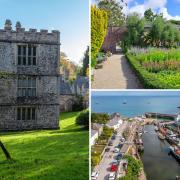In our February/March issue, Cornwall Life introduces some sea and coastal paintings and what they might mean. A painting of the sea is in the same genre as landscape painting and we selected a few to look at in some detail. Really top land...
Aren't we lucky to live in the Westcountry, surrounded by countryside and coastline? It's rhetorical really, but you must have heard that question before: 'Aren't you lucky living here?' Of course we are, but for most of us luck has nothing to do it. We live in the Westcountry through choice and circumstance. One of my old school friends moans that it is unfair that we are here and he is in Milton Keynes. He works for the Metropolitan Police, his wife is a long-haul air hostess for British Airways. In no particular order, they have two children, lots of time apart, a Polish nanny, big mortgage, no view and plenty of stress. But they both rather fancy the thought of a decent pension. Irrational - and sad. I tell him that we do have mortgages in the Westcountry and some people actually get stressed here too. In fact I must tell you, and this is true, about the young professional woman from London who was most surprised that I had a job at all, because she had heard that few people work in the Westcountry.
So where does my rant get us with looking at paintings? Well, it's a roundabout way of introducing some sea and coastal paintings and what they might mean to lucky old us kicking our heels and staring out across the waves. A painting of the sea is in the same genre as landscape painting and I have chosen one real beauty - Kelp Gatherers by Henry Moore. Really top landscape painting has a monumental majesty and is truly awe-inspiring.
There is plenty of critical meaning too that can be gleaned from top-quality landscapes. John Constable's work can be interpreted as a tribute to nature but it is also laced with political and social metaphors and concerns. Good sea painting has equal majesty and, for those so inclined, a religious quality too.
This painting by Moore is an exceptional example of the artist's rather mixed body of work. The composition techniques of dividing the painting into thirds on horizontal planes and using a diagonal focus from each bottom corner successfully orientate the viewer and pull them into the painting. What really makes this painting special, though, is the treatment of light and in particular the burst of sunlight through the breaking clouds. This dynamic shaft of brilliant light explodes on the distant horizon. The result is that the figures in the foreground, gathering kelp, pale into insignificance before the real action - nature dominating the world. The statuesque kelp gatherers and their horses will come and go with the tide, but the rumbling, grumbling, menacing power and intensity of the sea and the sun has a presence and significance beyond mere human lives.
Contrast this view with the painting of The Fisher-Boy by Walter Langley. Here the figure dominates the picture, or at least seems to. There is more narrative in the painting, with the artist's title offering the viewer a clue to interpret the image. Again, the composition is arranged into horizontal thirds with a prominent horizon line. Langley paints the most wonderful reflection of the boy in the wet sand, which complements the day-dreaming reflective expression of the subject. As he clutches a toy boat one feels sure that the boy is wondering about his future and what will become of him. Langley is a major father-type figure in the community of Newlyn painters, with strong political views, having experienced at first hand social deprivation and poverty. He saw painting both as making a living and as a medium for expressing his views on realism and society. The big question in this charming picture of the boy is, 'What will become of me and what can I do about it?'
Here is another painting of the sea, by FJ Widgery. This painting is confidently divided along the horizon line, with one lone white cloud reflecting the white froth of the breaking wave, which, together with some carefully shaped and angled waves, lifts the viewer over the sea to the horizon. Very clever. And I imagine painting the sea and rolling waves is a real skill because it is the wobbly bit between the land and the sky.
Widgery's painting is full of drama and movement, but as a contrast look at the modern painting of Topsham by Colin Burns. Burns is a successful artist living in Norfolk who has an excellent international reputation and regularly sells in five-figure sums. Here is a beautifully atmospheric view looking up the River Exe at low tide. The horizon line, dotted with moored boats, echoes the same line that Widgery painted above his sea and there is a great emphasis on perspective along the wall and the gullies at low tide. In contrast to Widgery's ocean, stillness, calm, nature and man are the words that spring to mind.
As a final example of a different interpretation of the sea, look at Peter Greenham's view of Mundesley. This has less of the drama of tone and light and emphasises a harmony between man and the sea by depicting them as one. Here the pastel colours and narrow tonal range, the loose handling of paint and soft lines make a new statement about the sea; it might just be the wobbly bit between the land and the sky, but step in and enjoy.
So it's true that we are very lucky to live in the Westcountry and we are privileged that some of our great painters think so too and have imprinted their interpretation of our coastlines and countryside on canvas.


























